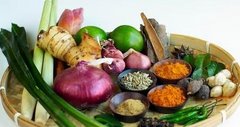
- 250g cabbage, cut 3cm in size
- 1 whole cucumber
- 150g cauliflower, cut into small florets
- 150g carrots, cut into 3 cm lengths
- 100g French beans, cut into 3cm lengths
- some red and green chillies, cut to look like a flower and seeded
- 1/2 tsp salt
For scalding vegetables:
- 600 ml water
- 300ml rice vinegar
- 2 tbsp sugar
- 1 1/2 tsp salt
Spice paste (ground):
- 20 dried chillies
- 10 shallots
- 5 cloves garlic
- 1 stalk serai (lemongrass)
- 2" lengkuas (galangal) sliced
- 4 buah keras (candlenuts)
- 20g belacan
- 2 tbsp ketumbar powder (coriander powder)
- 3 tbsp rice vinegar
- 10 tbsp sugar
- salt to taste
- 100g peanut, roasted and coarsely pounded
- 5 tbsp sesame seeds
Method:
Quarter the cucumber lengthwise without peeling the skin and remove the core. Cut into 3cm long strips. Knead 1/2 tsp salt into the cucumber slices and leave aside for 1-2 hour. Wrap the cucumber slices in a clean towel and squeeze out as much liquid as possible. Lay the cucumber slices on a tray and sun for 2-3 hours.
For other vegetables, sun them separately in trays for 1-2 hour. If you are in UK and there is no much sun light, you can leave the vegetables over night as the air is dry compare to Malaysia.
Bring water, vinegar, salt and sugar for scalding vegetables to a rapid boil. Blanch the dried vegetables one type at a time, 5 seconds for cabbage (suggest that you boil the thicker part of the cabbage longer) and cauliflower and 2-3 seconds for the rest of the vegetables. DO NOT OVERCOOKED the vegetables or they will loose their crunchiness. Drain the vegetables and set aside.
Fry the spice paste in hot oil until the oil rises and separate from the paste. Season with sugar and salt. Bring it to a boil. Stir in 3 tbsp of rice vinegar, turn-off the heat and set aside.
Add in all the vegetables, grounded peanuts and toasted sesame seeds and mix well. This dish is best to eat the next day. Keep it in a bottle and it will last you a while ( I hope!)









































